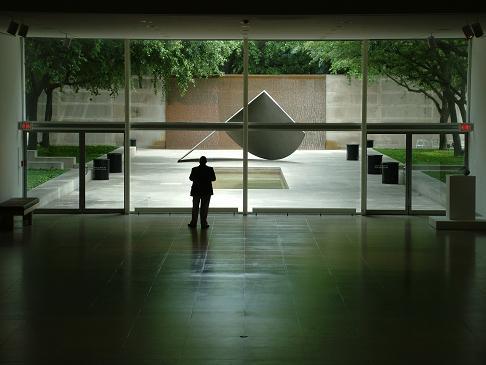The City of Dallas’ Cultural Affairs Office released the news that according to a new study, Dallas ranks among the top 10 cities nationally in the number of arts-related businesses and arts-related employees. Creative Industries 2008: The 50 City Report, a new study by Americans for the Arts, presents detailed analysis of arts-related businesses, institutions, and organizations in the country’s 50 most-populated cities. Dallas ranks 7th in arts businesses, with 4,297 arts businesses identified through the research, and 6th in the number of employees in arts businesses,with 27,883 people employed in the creative industries sector.
Whatever their weaknesses (which I’ll get to in a moment), such studies do often give a broader sense of the scope of a city’s cultural community and its relative merits and weaknesses compared to other cities. For instance, when it comes to arts businesses, the top cities are thoroughly predictable because they are America’s largest cities — culture tends to move with the population and the economy. They’ve been major media/art industry centers for years: New York, LA, Chicago. In fact, there’s a sizable gap between those cities and the ones that follow; that’s how ‘central’ these cities are to the “American cultural industry.”
The shock comes with Houston …
… which ranks fourth — above San Francisco (although in the other chart measuring the total number of art employees, Dallas rates higher than Houston, and both cities are below San Francisco). Another (more) pleasant surprise: Dallas ranks directly above Seattle in arts businesses, while Austin slips in below Seattle but above Phoenix.
Frankly, I was taken aback by Phoenix’ high rating. We learn a lot, though, when we compare these arts business numbers to population. That is, Phoenix is three times the size of Seattle and twice the size of Austin, yet it trails them in the number of arts business. That reveals just how significant a force the arts are in a community: They’re three times more prevalent in Seattle than in Phoenix.
For its part, Dallas is almost twice the size of San Francisco, but trails it in the number of arts businesses. Meanwhile, as a state, Texas ranks third — behind New York and California, another instance of culture following population.
Still, I have become wary of and unpersuaded by the various “arts impacting the economy” arguments (they crop up across the country whenever a city is pushing a bond issue for a new arts center). For example, the number of “arts-related employees” is actually a fairly crude representation of an arts community. It’s perfectly possible to have a sizable theater company, say, with assistants and custodians and set builders but a theater company that barely supports any local working stage artists outside of the director himself. The company makes a splash in terms of total staff jobs, but if the stage shows (and artists) are mostly imported, then that doesn’t really reflect a healthy area theater community.
I do appreciate the bottom-line forcefulness of the case being made to businessmen — the arts aren’t just some part-time hobby that the executives’ wives drag them to in the evenings. But the economic case misses much of the real value of the arts to individuals, to a community, to education. Pretty much the same business-impact argument, after all, is made for public funding of sports arenas, and that’s an equation I have profound difficulty accepting. When non-profit museums and dance companies enjoy the advertising and media deals that team owners, the NFL and the NBA have, and when a professional sports franchise improves the quality of local libraries or school programs, then I’ll be more open to the equation. Bluntly put: The arts need our support, it seems to me, regardless of whether they’re “good for business.”
You can see the various data and charts (by state and Congressional District and even state legislative district) at the Americans for the Arts website. But these are the two relevant city tables:
TOP 10 OF THE 50 MOST POPULATED CITIES RANKED BY ARTS BUSINESSES
City
Arts Businesses 2008
Arts Employees 2008
Population (2006 Estimates)
Population Rank
1.New York,NY
26,714
229,579
8,214,426
1
2.Los Angeles,CA
18,160
120,794
3,849,378
2
3.Chicago,IL
6,263
51,330
2,833,321
3
4.Houston,TX
5,342
25,433
2,144,491
4
5.San Francisco,CA
4,837
29,561
744,041
14
6.San Diego,CA
4,432
24,324
1,256,951
8
7.Dallas,TX
4,297
27,883
1,232,940
9
8.Seattle,WA
4,065
21,025
582,454
23
9.Austin,TX
2,813
14,337
709,893
16
10.Phoenix,AZ
2,796
15,107
1,512,986
5
TOP 10 OF THE 50 MOST POPULATED CITIES RANKED BY ARTS EMPLOYEES
1.New York,NY
26,714
229,579
8,214,426
1
2.Los Angeles,CA
18,160
120,794
3,849,378
2
3.Chicago,IL
6,263
51,330
2,833,321
3
4.Philadelphia,PA
2,481
39,721
1,448,394
6
5.San Francisco,CA
4,837
29,561
744,041
14
6.Dallas,TX
4,297
27,883
1,232,940
9
7.Houston,TX
5,342
25,433
2,144,491
4
8.San Diego,CA
4,432
24,324
1,256,951
8
9.Atlanta,GA
2,430
23,198
486,411
34
10.Seattle,WA
4,065
21,025
582,454
23







0 Comments